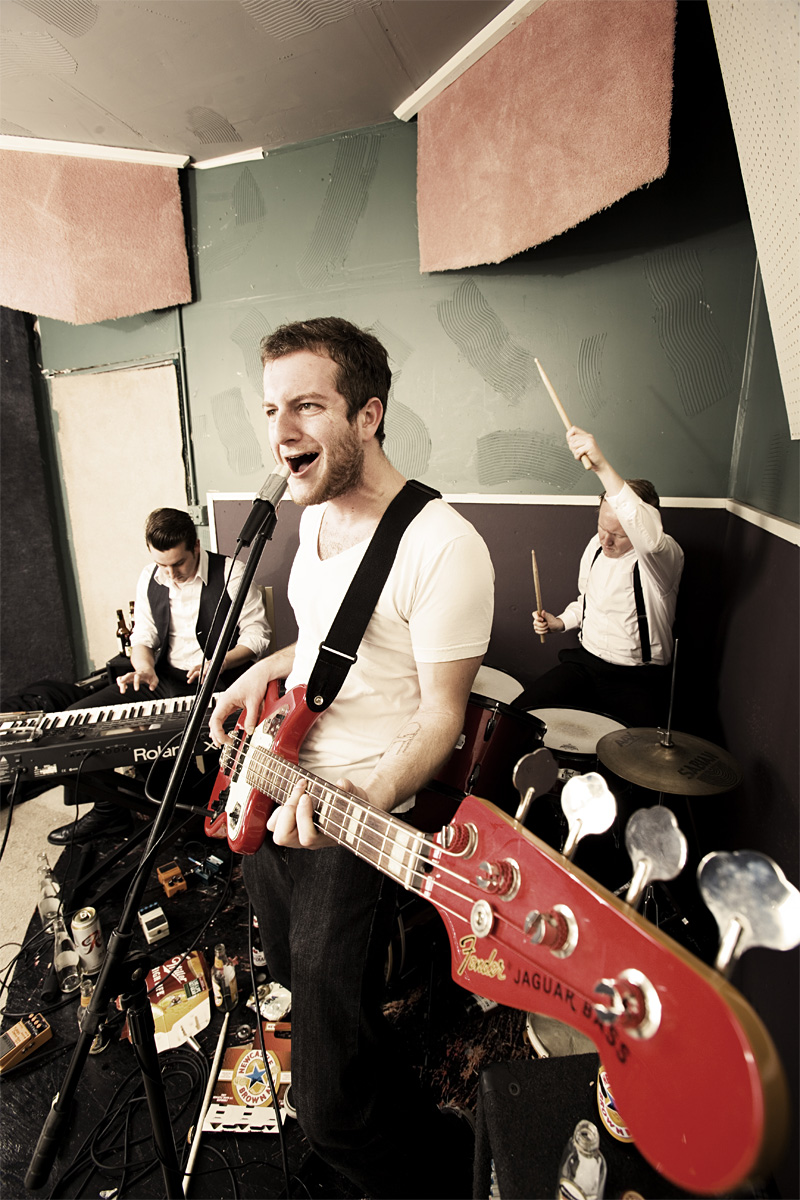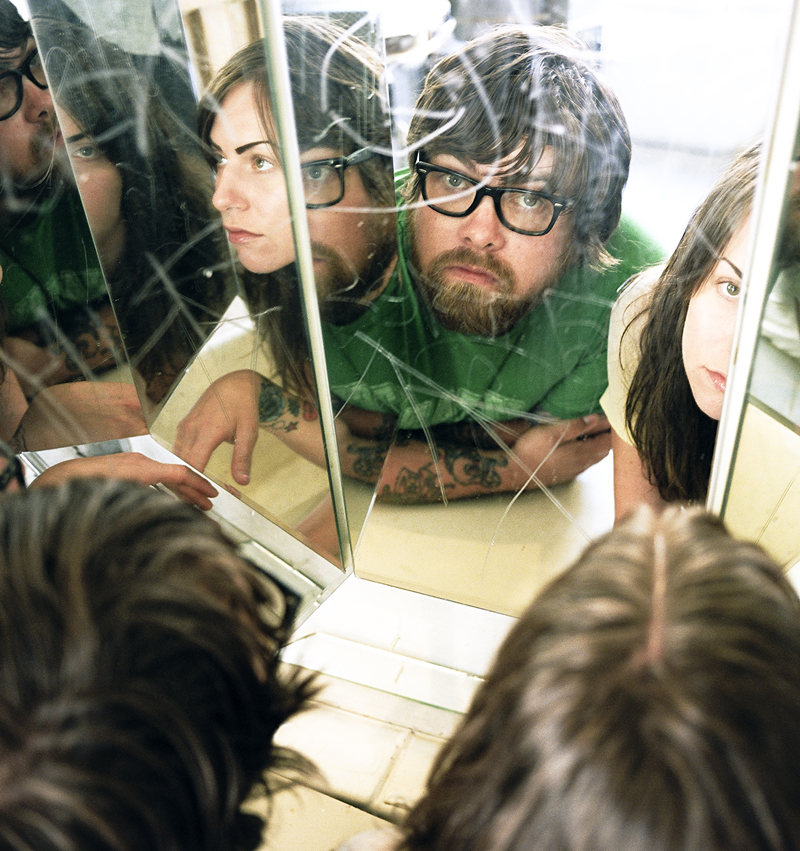Listening to the first track from Seattle trio Blood Red Dancers’ 2008 debut EP, Let Them Fight, I’ll Be in the Breadline, feels like watching the scene in Night of the Living Dead when Barbara gets attacked in the cemetery. In “Sweetie’s Gettin’ Mobbed,” a shrill, cacophonous organ (generated by a decrepit Roland XP60 and a couple of distortion pedals) wails along with Aaron Poppick, whose acrid, gravelly howling comes partnered with a sinister bass line.
No guitar is needed to generate this ominous, percussive psychedelia, in which the lyrics are almost universally about dysfunctional sexual relationships, violence, and the hideous depths to which humans can sink. It’s like taking a little too much acid right after reading The Destructors, then watching everything melt around you—but being too engrossed and powerlessin theface of your environment’s collapse to tear yourself away. It’s powerful stuff, but the band’s dry sense of humor and irresistible pop hooks keep the music from becoming so heavy with gloom and bitter fury that it sinks altogether.
“I’m a really angry person,” Poppick, who writes all the band’s lyrics, says over a pint at the Stumbling Monk, a dim Capitol Hill bar that specializes in Belgian beers.When asked if his music is supposed to feel like watching a horror movie,Poppick nods in assent. “When you look at Holocaust pictures and footage, it moves you. It really hits you, and you’re like, ‘Wow, this is really ugly, and powerful, and necessary,'” he observes.”I want to write songs that do that.”
Poppick, with drummer Kevin Lord and pianist Julian Thomas, are here to discuss The Bikini Island EP,their follow-up to Breadline.The current effort issimilar toBreadline in that a vein of simmering fury runs throughboth, but the EP couldn’t possibly sound more different. Here theorgan all but disappears, leaving a more ordered, precise piano in its place. Furthermore, drums are featured more prominently, while comparatively understated bass lines fade into the background. Poppick’s vocals are more melodic as well.
Though Bikini Island sounds as if it could be the title of a ’60s surf flick with an Elvis look-alike wielding a ukulele, the reality is much more chilling: Bikini Island is a real place in Micronesia that became a contaminated wasteland after the American government used it as a nuclear testing site. It is also the island after which the practically ubiquitous two-piece swimsuit was named in 1946. That juxtaposition of something as pleasant and sexually arousing as a bikini and as frightening as the possibility of nuclear war epitomizes the Blood Red Dancers’ approach to songwriting.
“We actually sat down and watched Mondo Cane the other night,” Lord says. “It’s a 1960s film that shows a whole bunch of footage of the atrocities of mankind. Bikini Island is in it.” Poppick jumps in to elaborate. “They show these sea turtles that are so plagued with nuclear radiation from all the testing that they lay their eggs and all the testing makes them so sick that they go inland instead of back out to sea,” Poppick says. “So there’s just all these dead sea turtles lying on their backs, and there are all these birds picking at their bones.” “And then in front of all of that,” Lord interjects, “just put a WASPy girl in a little bikini shakin’ it a little bit and drinking a fuckin’ mai tai.”
The humor of the contrast causes him and his bandmates to howl with laughter, attracting the attention of the French conversation group chatting behind them. Poppick smirks and shakes his head a little. “Yeah, that’s the Blood Red Dancers’ idea of a fun night: Us sitting around in the dark in Kevin’s apartment drinking and watching this horrible movie of all these sea turtles dying from radiation on this Bikini Island,” he says. This exchange comes in what seems like one run-on sentence, each man interjecting halfway through the other’s thought whileThomas, fresh off a 30-hour flight back from visiting family in New Zealand, blinks blearily and occasionally interjects with a surprisingly in-depth knowledge of Bikini Island’s history.
It’s the sort of dynamic you’d expect from people who’ve known each other most of their lives. Poppick was friends with Thomas and Lord as kids in Glendale, Calif., and introduced the pair to each other as adolescents. “We actually all met together to go to a Smog concert, back when we were 15,” Poppick says.
Smog and the Smiths, Thomas adds, were formative musical influences. While the latter obsession is not so evident on Breadline, it is palpable on Bikini Island; there’s something about the way Thomas plays that smacks of the piano sound employed on the Smiths’ Louder Than Bombs, particularly during the instrumental track “Oscillate Wildly.” Breadline, on the other hand, garnered a different comparison.
“Everyone started saying that we sounded like the Doors after our first EP, and we were like, ‘That’s fucking rad, we like the Doors, but that was not our intention,'” Poppick says. On Bikini Island, Poppick’s vocals sound more like Tom Waits than Jim Morrison—though Poppick’s gruff growl is more melodic than Waits’ famously unpretty grumbling.
Though they’re reluctant to admit it, the band’s pop makeover is a bid to attract the attention of a larger audience: specifically, KEXP’s audience.This is why the band decided to shell out to record Bikini Island at Avast, a studio that’s been patronized by artists from Cat Power to Built to Spill, rather than in a home recording studio owned by Poppick’s boss.
Problem is, while Bikini Island is poppier than its predecessor, it’s also not as approachable. In its quest to differentiate itself from the ’60s garage sound it started with, the band sacrificed the instant accessibility that is emblematic of most pop music. Whereas Breadline offers instantly catchy bass hooks that snare the ear in seconds, Bikini Island‘s jazz-influenced piano parts and moody Morrissey moments take longer to sink in; it’s telling that the EP’s best songs are those that don’t stray quite as far from the formula the band used the first time. “Rainy Day Rag” retains some of that psychedelic cacophony, though a tinny piano takes the place of a humming bass guitar, and “Hold You Like a Gun” has drums, not bass, in the foreground.
If the band can strike a balance between the two EPs on a future release, only then will KEXP—and everyone else—start paying attention. Thankfully, then, it seems unlikely that the band will venture much further into shiny, upbeat pop territory. “Hookers and drugs and alienation and obsession, all of that shit captures my attention,” Poppick says. “You know, that imagery that shows the ugliness of things.”






